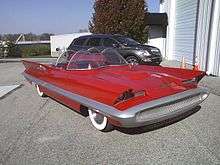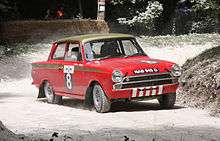Roy Brown Jr.
Roy Brown Jr. (October 30, 1916 – February 24, 2013) was an American car designer and engineer, best known for creating the first Ford Edsel automobile model in 1958 and the exterior for the Ford Zephyr.[1]
Automotive career
Brown was born in Hamilton, Ontario, but his family moved to Detroit when he was in his teens. His father was an engineer for Chrysler.[2]
Following his graduation from Detroit Art Academy in 1937, he was hired by General Motors as a designer in its Cadillac division, working alongside Bill Mitchell. "The first thing he designed was an instrument panel for the 1939 Cadillac," his son Reg told The Los Angeles Times.[2]

After a stint in the U.S. Army, he was hired by Ford Motor Company, where he was assigned to oversee design of the 1955 Lincoln Futura, the model that would be transformed into TV's Batmobile a decade later.[2]
Edsel

Ford next assigned Brown the task of designing a model that would appeal to buyers "with upscale tastes and mid-range budgets."[2] Brown designed a car that "blared individuality."[2] He rejected the tail fins prevalent in that era for rear lights shaped like boomerangs and gave the car a unique vertical front grille.[2]
The model, named Edsel after Henry Ford's only child, rolled into showrooms in 1957, accompanied by a massive publicity campaign.[2] But only 63,000 Edsels were sold in the first year of production, with its distinctive grille being the most criticized feature.[2]
Ford canceled production of the Edsel in November 1959, and Brown would tell acquaintances "I cried in my beer for two days."[2]
Post-Edsel

Brown gained attention in 1958 for creating the now-infamous "horsecollar" in response to engineers' concerns about engine cooling problems.
Ford transferred Brown to England, where he designed the 1962 Ford Cortina, which would become the automaker's best-selling car in Great Britain.[2]
After returning to Detroit in 1966, Brown helped design Ford's Econoline van. He later became executive designer in the Lincoln Mercury division.[2]
Brown remained a fan of the Edsel and drove an Edsel convertible into his 80s.[2] "People would ask him, 'What the hell were you thinking when you designed that car?' He was never offended. He was proud of his creation," said Larry Nopper, a past president of the Southlanders Edsel Owners Club.[2]
Brown retired from Ford in 1974. He died in Ann Arbor, Michigan[2] from Parkinson's disease.[3][4][5]
References
- ↑ Yardley, William (5 March 2013). "Roy Brown Jr., Edsel Designer, Dies at 96". New York Times. Retrieved 8 March 2013.
- 1 2 3 4 5 6 7 8 9 10 11 12 13 14 Woo, Elaine. (2013, March 9). Roy Brown dies at 96; designer of Ford's Edsel. The Los Angeles Times.
- ↑ "Roy Brown Jr., believer in Edsel". Philly.com. Retrieved 8 March 2013.
- ↑ "Marvine Gaye's family drama Ford Edsel designer Roy Brown Jr.". The Washington Post. Retrieved 8 March 2013.
- ↑ "Roy Brown, 96, Designed The Edsel's 'Horsecollar'". Media-Post. Retrieved 8 March 2013.